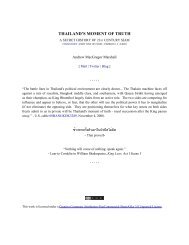THAILAND'S MOMENT OF TRUTH - ZENJOURNALIST
THAILAND'S MOMENT OF TRUTH - ZENJOURNALIST
THAILAND'S MOMENT OF TRUTH - ZENJOURNALIST
You also want an ePaper? Increase the reach of your titles
YUMPU automatically turns print PDFs into web optimized ePapers that Google loves.
impressing on the people that the king is not dead, but has migrated to a higher plane, where he<br />
will work out his destiny as a Bodhisattva for the good of all beings. The mixture of Brahmanism<br />
and Buddhism is fortunate: the former lends itself more to the exaltation of the kingship, while<br />
the latter emphasises the royal protection of the people's religion and enables them to enter into<br />
the spirit of the ceremonies...<br />
Bhumibol’s coronation ceremony was similarly infused with ancient symbolism common to the ancient<br />
kingdoms of Ayutthaya and Angkor, and lost Southeast Asian empires even more distant in history.<br />
In the cosmologies of monarchy adopted adopted by their rulers, the king is at the centre of concentric<br />
circles of power that radiate outwards from the palace, through the capital city and the wider realm.<br />
The king is a microcosm of the country, and a monarch who is attuned to the natural order through<br />
his virtue will naturally bring order and prosperity to the realm, And in turn, that brings order to the<br />
wider macrocosmos: the turning of the seasons, the orbit of the planets and the stars, the harmony of the<br />
universe. In the words of Robert Heine-Geldern in Conceptions of State and Kingship in Southeast Asia in<br />
The Far Eastern Quarterly in 1942:<br />
According to this belief humanity is constantly under the pressure of forces emanating from the<br />
directions of the compass and from stars and planets. These forces may produce welfare and<br />
prosperity or work havoc, according to whether or not individuals and social groups, above all<br />
the state, succeed in bringing their lives and activities in harmony with the universe... Harmony<br />
between the empire and the universe is achieved by organizing the former as an image of the<br />
latter, as a universe on a smaller scale.<br />
In such cosmologies. Heine-Geldern writes: "The king is identified with the axis of the universe. The<br />
same idea seems to be expressed by the title Paku Buwono, 'Nail of the World', of the Susuhunan of<br />
Solo in Java." Literally at the political and geographical centre of the realm, and just as importantly at<br />
the spiritual centre of the cosmos, the king brings harmony by good governance. Bhumibol's coronation<br />
emphasized his position at the centre of the universe.<br />
In Southeast Asia, even more than in Europe, the capital stood for the whole country. It was<br />
more than the nation's political and cultural center: it was the magic center of the empire. The<br />
circumnambulation of the capital formed, and in Siam and Cambodia still forms, one of the most<br />
essential parts of the coronation ritual. By this circumnambulation the king takes possession<br />
not only of the capital city but of the whole empire. [Heine-Geldern, Conceptions of State and<br />
Kingship in Southeast Asia]<br />
- - - - -<br />
In The Revolutionary King, William Stevenson recounts stories likely to have been told to him directly by<br />
Bhumibol and those in the king’s inner circle. In the grim weeks and months after the death of Ananda,<br />
Stevenson says, with the future of the monarchy in doubt and his movements monitored by agents of the<br />
generals who wanted to usurp the primacy of the palace, the 18-year-old King Rama IX would often slip<br />
secretly out of the Grand Palace wearing a singlet, shorts and sandals. Sometimes he sneaked out on foot,<br />
to listen to the talk of ordinary people while eating Thailand's incomparable street food. And sometimes




